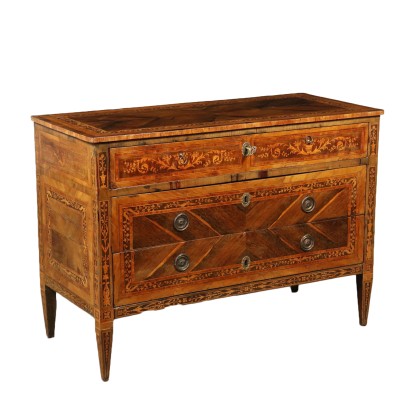Elegant Neoclassical Chest of Drawers Italy Last Quarter of 1700s
Features
Style: Neo-Classical (1765-1790)
Age: 18th Century / 1701 - 1800
Origin: Italy
Main essence: Brazilian Rosewood , Olive
Material: Walnut Slab , Palm Wood
Description
Elegant Neoclassical chest of drawers with two drawers and reserve in the middle made of quadripartite palm wood plus further drawers under the top with two aligned reserves. Pyramidal feet, reserves with maple inlays. Richly inlaid with threads of different species. Manufactured in Italy, last quarter of the 18th century.
Product Condition:
The item shows signs of wear due to age. Any damage or loss is displayed as completely as possible in the pictures. It may require restoration and recovery of french polish.
Dimensions (cm):
Height: 90
Width: 125
Depth: 56,5
Additional Information
Style: Neo-Classical (1765-1790)
This historical period includes a first phase that can be properly defined as the Louis XVI style.nOnly at a later time, with the maturation of archaeological fashions, was a new vision of furnishing civilization formulated and codified, now fully attributable to the Neoclassical Style.
In fact, both trends coexisted in unison until the last years of the eighteenth century.
nIn the field of cabinet making, the Directoire, Retour d'Egypte, Consular and Empire styles also fall within the neoclassical era.
nFind out more about Neoclassicism with the insights from our blog...
n


































